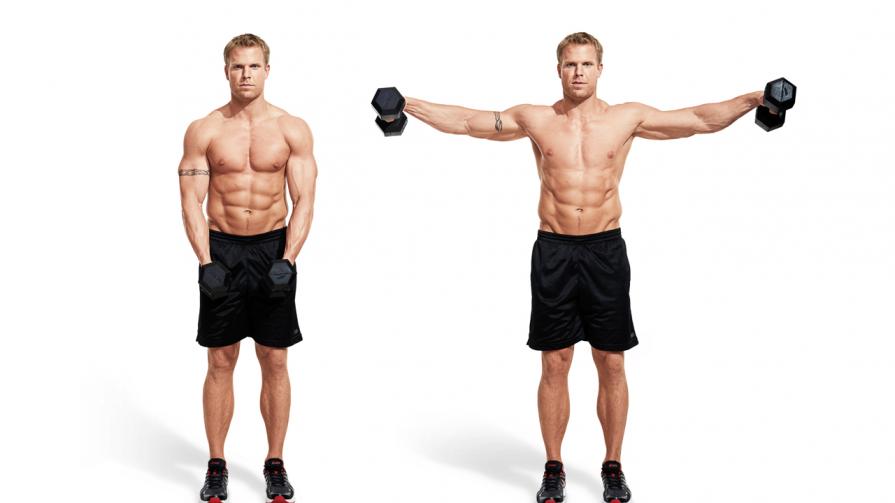
The dumbbell side raise recruits the middle (lateral) head of the deltoids, or in other words, the region to the side of the shoulders which is generally responsible for width. The side raise, when performed correctly, contracts the lateral head via shoulder abduction and is an effective exercise to isolate the head due to minimal secondary muscle involvement. The dumbbell side raise should be a great choice for at the beginning of a shoulder workout as a tool for fatiguing the lateral head prior to shoulder pressing.
Execution of the side raise
The side raise can be performed with various training equipment, such as cables, kettlebells, and specific side raise machines. The movement is basically the same for each variation, and below is a summary of how to perform the dumbbell side raise.
- Stand upright grasping a set of dumbbells down in front of your thighs.
- Bend at the knees and hips slightly, and fix the elbows at a slight bend (around 20 degrees).
- Whilst maintaining the bend in the elbows, bring the upper arms upwards in an arc so the elbows are at shoulder height. Pause for a brief moment. Do not allow the wrists or dumbbells to travel higher than the elbows during the movement.
- Slowly reverse the movement back to the starting position.
Performing the side raise incorrectly will reduce its effectiveness greatly, as well as having the potential for causing injury. Below are some tips to ensure maximum effectiveness:
- Maintain a slight bend at the hips throughout the exercise (bending forward slightly).
- Minimise any flexing of the elbow during the side raise.
- Do not allow the wrist to travel higher than the elbow at any point of the exercise, by doing so the front (anterior) head of the deltoid will take over.
- Keep the raise directly to the side of the body for maximum lateral head recruitment. Bring the arms slightly forward will heighten the anterior head’s involvement, and by bringing the elbows back the stimulus to the middle head is lessened.
Variations of the side raise
As briefly mentioned, the side raise can be performed with a handful of other training apparatus.
Cable side raise – Standing next to a low cable pulley, grasp onto the attached D handle and allow the cable to come across the front of your body. Perform the side raise in exactly the same form as the dumbbell variation. Some people prefer the cable version of the exercise, with the cable providing a smooth and continuous resistance. The angle of the resistance is somewhat different than the dumbbell side raise also, so this could make for a good change for those who have traditionally stuck to the dumbbell variation.
Side raise machine – Some gyms will not have this piece of equipment. There will likely be various machine types, with the majority have two arms which have pads and handles fitted to the end. The trainer can then raise the arms by raising his/her own arms in an arc to the side whilst grasping the handles. This type of machine may be hit and miss, greatly depending on the manner in which the trainee usually performs the side raise, and also limb length. If the exercise feels uncomfortable or unnatural, stop right away.